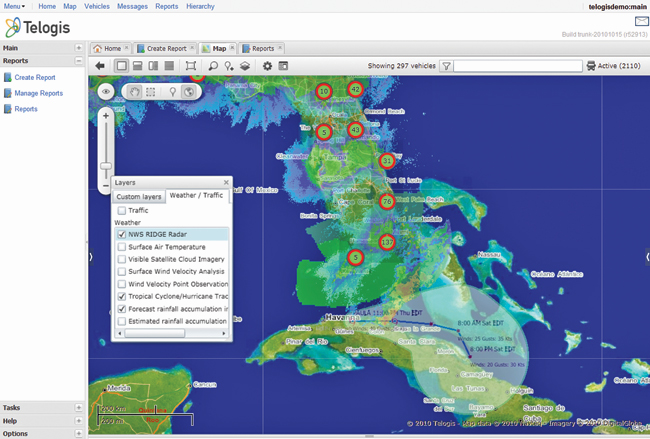Achieving True Location Intelligence
When considering how location intelligence technologies are deployed — systems such as GPS-based fleet management, routing, navigation and work order management — most companies are only scratching the surface of the capabilities afforded by these services. Viewing them all under the popular umbrella term “telematics” is limiting. If all a company is doing is dispatching mobile workers to jobs, tracking the location of its trucks or monitoring the miles and hours since an asset’s last scheduled maintenance, it is not realizing the full possibilities of location intelligence.
It’s time to think beyond points on a map and look at advanced location intelligence: How can I use location intelligence technologies to create a better understanding of what happens in the field on a daily basis and create actionable information to improve operations?

In this article we’ll examine key areas where companies are experiencing the revolutionary benefits of advanced location intelligence Software-as-a-Service (SaaS) applications, including asset utilization and security, work order management, safety and reporting. In most cases, these added capabilities are achieved using the same transmission devices already mounted on the vehicle for your GPS-based fleet management system and require minimal IT infrastructure upgrades thanks to the SaaS Web-based model.
A Refresher: What Is Telematics?
Telematics is the science of combining the GPS hardware installed on each asset with a Web-based software platform. It takes location-based data and converts it into reports and programs that allow business owners and fleet managers to more accurately track and allocate field resources based on real-time metrics. The implementation of such a platform also lowers operating costs, assists in the recovery of stolen equipment and provides management with methods of accurately managing employee productivity and allocating resources to locations where they are needed most. It may seem overwhelming to think that each of these assets and its actions could possibly be tracked and reported by one central system, but the practical application of the technology is much simpler than you may think.
Fleet Management and Mobile Workforce Management Systems
In terms of productivity, location intelligence technology gives you valuable insight into the performance of your employees in the field. Telogis Fleet, by way of example, offers a feature known as the Field Management Co-Location module. This module uses GPS data to report on the amount of time a field supervisor’s vehicle spent in the proximity of other assets and crews in the field. Such information allows fleet managers and supervisors to better understand if field generals are doing their work or are spending too much time away from their crews. Another feature called Multiple Vehicle Histories allows the fleet manager to view current and historical data of multiple assets in a single window, a feature that easily tracks potential drags on productivity and cost, such as incidents of mobile workers congregating in a single location for too long.
While work order management software solutions aren’t new, their scope and integration with other systems, including fleet management and routing/navigation, is creating new opportunities for improved productivity and customer service. Through advanced SaaS work order management applications, contractors can create and track jobs (including estimated time of arrival and completion), route and dispatch mobile resources (including pre-planned routes and dynamic changes throughout the day), generate customer service notifications, report on route compliance and job completion, offer real-time traffic and weather conditions and interface with existing enterprise resource planning (ERP) and customer relationship management (CRM) systems.

These systems give contractors insight into the productivity and performance of their assets in the field by measuring equipment utilization through metrics and reporting via dashboards, including the ability to look at jobs and measure performance based on planned vs. actual. It serves as an excellent customer service tool as the contractor can monitor each crew’s performance and create accurate estimates as to when the crew may get to a specific job or when a job may be completed.
Driver Behavior Metrics Improve Safety, Location Intelligence Reduces Liability
Safety is arguably the highest corporate commitment in the construction industry. Your company’s name is on the side of that truck, and any action your driver takes outside of acceptable driving practices reflects poorly on your company and endangers the safety of the public, your employees and your assets. Incidents such as hard braking, hard acceleration, hard turns, speeding against posted speed, out-of-route driving and excessive idling are documented on a driver scorecard to bring awareness to bad habits and encourage changes to achieve compliance.
Similarly, using location intelligence applications, contractors can document when and where their vehicles operated in order to protect themselves against false claims of damage caused by vehicles or reckless driving. By matching the vehicle location with the time and location of the complaint, it eliminates the opportunity for the he-said/she-said element and provides concrete evidence either supporting or refuting the claim.
Construction fleets also often work in remote locations that may be off-road or in rural areas with few people and poor cell phone coverage. The ability to know the real-time location and activity of that vehicle and to determine whether an employee may need help or be in distress is a critical safety benefit of any location intelligence system. In these cases, location intelligence systems will use both cellular and satellite connectivity for real-time data transfer.
Minimizing Unauthorized Use of Company Assets
Another key benefit of a true location intelligence system is its ability to ensure proper use of company-owned trucks and equipment during downtime. Contractors can compare vehicle mileage and location to work schedules and pinpoint the exact amount of mileage and expense that is attributable to the job, and how much of it was used on personal time by an employee. Similarly, systems are available that leverage fuel card data and GPS location to better manage fuel purchases. In addition to recording fuel card transactions, the system compares the transactions to GPS-provided vehicle locations to verify authorized use. If a card is used without an approved vehicle within a specified range, that information is called out to the fleet manager.
Asset Security Improved Through Geofencing and Tracking
The cost in both capital and lost production when a truck or piece of equipment is stolen can be a major expense. Mobile assets are vulnerable during emergency response scenarios and when working in rural areas, far away from headquarters, where a temporary depot or yard may be set up. Asset security is a major benefit of any location intelligence system that incorporates geofencing. With geofencing, alerts are sent to operations managers to alert them when an asset — be it a truck, excavator, generator or an equipment trailer — has been moved outside of a virtual boundary. This deters unauthorized use of assets, helps recover assets when they are stolen and ultimately helps reduce both equipment replacement costs and insurance rates, saving companies substantial amounts of money.
Integration with Mobile Devices Ensures Performance, Compliance
Integrating a mobile handheld solution with your location intelligence solutions helps improve safety by providing two-way communication between workers in the field and the back office. It also provides truck-specific routing (route trucks under load or HazMat regulations based on height, weight and width restrictions), captures hours of service, logs electronically and records and reports vehicle safety checklists to ensure safety compliance for vehicles on the road.
A DOT requirement for certain vehicles, inspection checklists ensure safe and responsible driving on the road. Drivers perform a routine inspection prior to leaving for the day as well as after they return. The mobile device captures a variety of conditions according to the FMCSA requirements, such as brake lines, lighting, suspension and many other categories to ensure fleets stay on top of safety management and vehicle maintenance knowledge.
Advanced Reporting Helps Streamline Operations
One of the greatest benefits of an advanced location intelligence solution is not only the visibility it gives you into daily operations, but the advanced reporting and compliance functions that help keep track of complex usage detail for your entire fleet of vehicles or group of employees. For instance, advanced IFTA/IRP data feeds for fuel/vehicle registration taxes are available that help companies with vehicles traveling through multiple states accurately and efficiently manage their compliance based on GPS data and determine the best place to register each vehicle. Advanced off-road mileage reporting is also available for those who work in states that have different tax rates and rules for on-road use vs. off-road use. This reporting differentiates and calculates how much of a vehicle’s use was off-road versus on-road for tax and reporting purposes, potentially earning tax credits or rebates.

Other Considerations
Ultimately, these capabilities just scratch the surface of what is possible when you deploy an advanced location intelligence system. These solutions are often extremely flexible and scalable to workforces and fleets of all sizes (including mixed fleets). They offer custom configuration options, such as GIS layering to personalize the mapping and data to best suit your organization’s infrastructure. Advanced location intelligence is also one of the easiest ways to help your workforce and fleet go green. Between intelligent allocation of resources, smart routing and reduced engine idling, these systems will help companies substantially lower their carbon footprint and have a positive impact on the environment.
These are just a few of the ways that SaaS technologies can help revolutionize how companies manage, communicate with and allocate their mobile assets and workforce. While employing a workforce or fleet management system is an excellent first step, there are countless ways contractors can optimize that system and integrate it with other applications and back-office systems to provide greater visibility into the daily operations of their crews in the field.
Tim Taylor is the Client Success Officer at Telogis Inc., and Sean McCormick is the Product Manager at Telogis Inc., based in Aliso Viejo, Calif.
